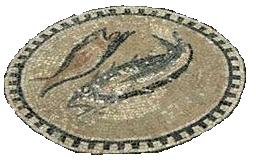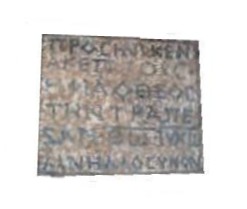Centurio Gaianus "Porphyrio"
and The Chapel of the Centurion of Armageddon
Estimated to be Early Third Century

The Mosaic in the Floor
October 30, 2005, the Israeli government discovered a small church, believed now to have been a chapel whose mosaic floor was donated by a Roman military officer named "Gaianus" (aka Porphyrio "our brother") and the Holy Table by a patroness: Akeptus, a friend of God, who presented the table to God, Jesus Christ, as a memorial.
The chapel is in Megiddo, a village in the historic, strategic Armageddon Valley famous for the many battles there, and the apocalyptic vision of St. John. News of the discovery was made public in November of 2005.
The mosaic floor of the chapel measured 6 x 9 meters, and has the name of Jesus Christ and two fish (the symbol of communion and the miracle of the feeding of the 5,000.) and the names of the Roman officer and several women who donated the building. See a detailed translation and interpretation of the inscriptions see this site.
The Chapel at Megiddo may be the oldest found to date; its rival is the church at the Roman military outpost of Dura Europos of about 240-241 AD. "One of the most dramatic finds suggests that, instead of an altar, a simple table stood in the center of the church, at which a sacred meal was held to commemorate the Last Supper." An inscription in the mosaic says, "Ekeptos donated this table to the god Jesus Christ in commemoration."
"The Antiquities Authority decribes the site not as a church but as a "prayer house" since it was apparently located inside a Roman officer's private home, according to one of the inscriptions."*
"Other findings that are indicative of early Christian rites are the central symbol of the fish, found in the mosaic, (later changed to a cross) and the fact that in one of the inscriptions, Jesus is referred to as "the lord Christos," a term which later disappeared. "*
"The inscription, which specifies that Aketous donated a table to the church, indicates the house of worship predated the Byzantine era, when Christians began using altars in place of tables in their rituals, Tepper said. Remnants of a table were uncovered between the two mosaics."
Photographs of three Greek inscriptions in the mosaic were sent to Hebrew University expert Professor Leah Di Segni, who told Haaretz on Sunday that the use of the term "table" in one of them instead of the word "altar" might lead to a breakthrough in the study of ancient Christianity. It is commonly believed that church rituals based on the Last Supper took place around an altar. "
For more information visit
ArmageddonChurch.com
